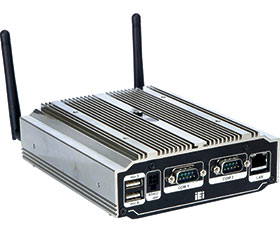

Reliability, cost, processing power and size are the most common factors when choosing a computer for an embedded system.
Reliability in any embedded system should be one of the most important factors considered by the designer and the end user, as they need to consider what time penalties sill occur if the system fails.
A simple climate monitor sitting in a remote location will have a very different cost consideration compared to an embedded system in a large production machine in a factory. In the first instance there is the travel and time cost involved in replacing or repairing the embedded system. In the case of a computer in a large production machine the cost can run to hundreds of thousands of Rands per day in lost production when a computer fails and cannot be immediately and easily replaced.
Processing power in an embedded system is generally determined by the complexity of the control and monitoring functions it must perform. Considerations include how much CPU power is required, and whether the CPU is fully loaded or running at less than full capacity and therefore less likely to fail.
Cost of an embedded computer is often given more importance than is justified – the cost of the computer should be weighed against the value of the product being produced or the cost of the failure of the system. Saving a thousand Rand on a system that produces hundreds of thousands or even millions of Rands of revenue is not logical. Even a low-cost system such as a climate monitoring system in a remote location can have a very high repair or replacement cost when time and travel are taken into account. Savings are quickly lost when a system fails.
The size of an embedded system is not always a critical factor when the computer is built into a very large machine, but in a handheld instrument, vehicle monitoring or remote monitoring system, size can be critical. When small size is required, issues of heat become critical and fanless embedded computers fill the needs of such systems. Environmental issues such as dust, heat, water and potential abuse or theft of the system must also be considered.
An example of the type of computer that fulfils these needs is the uIBX-210 from IEI. This tiny, fanless embedded PC boasts an Intel Atom CPU, dual display capability, Ethernet, serial and USB communications, and its size makes it portable.
Other examples are the DRPC-100 and DRPC-120 – DIN-rail mounted PCs which are available with a CANbus interface as well as all the usual capabilities. Both these computers provide fanless processing power in small packages for embedded systems.
For more information contact Henry Hugo, Centurion Micro Electronics, +27 (0)21 851 4904, [email protected], www.cme.co.za
| Tel: | +27 12 666 9066/8 |
| Email: | [email protected] |
| www: | www.cme.co.za |
| Articles: | More information and articles about Centurion Micro Electronics |

© Technews Publishing (Pty) Ltd | All Rights Reserved